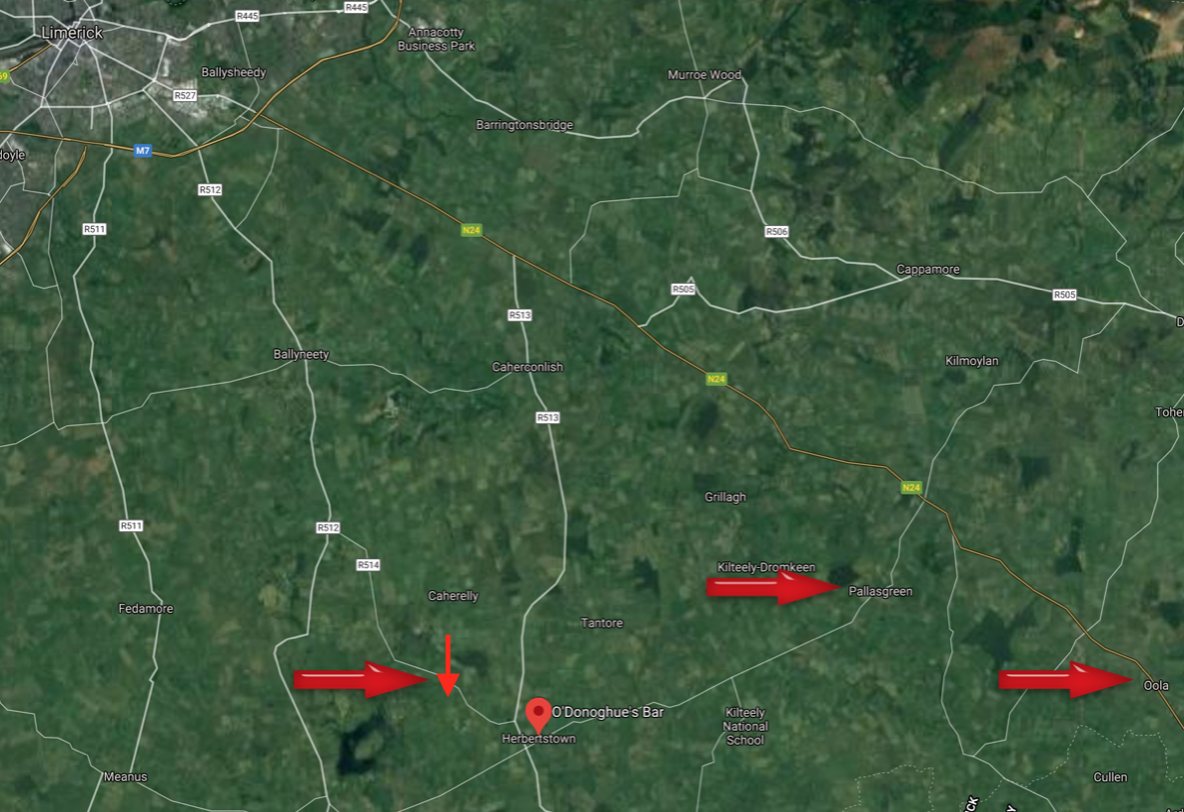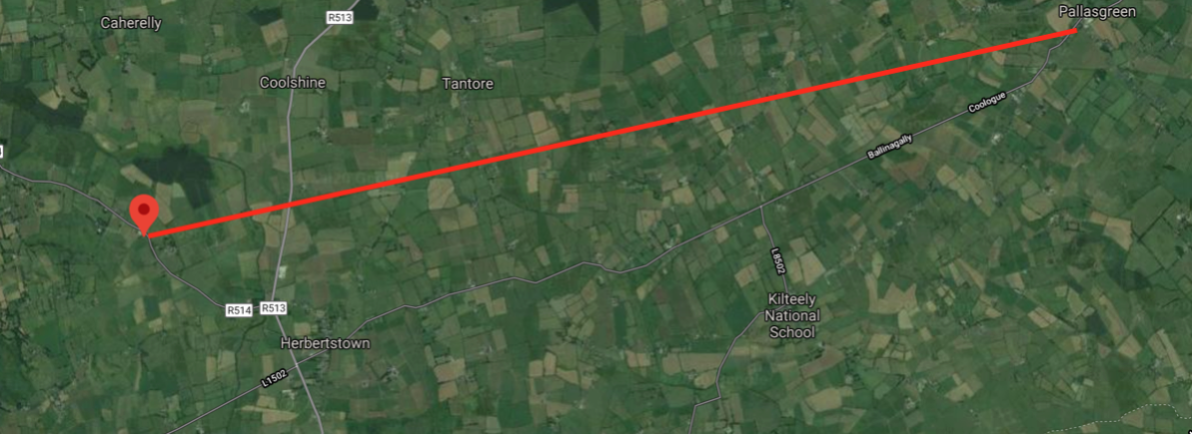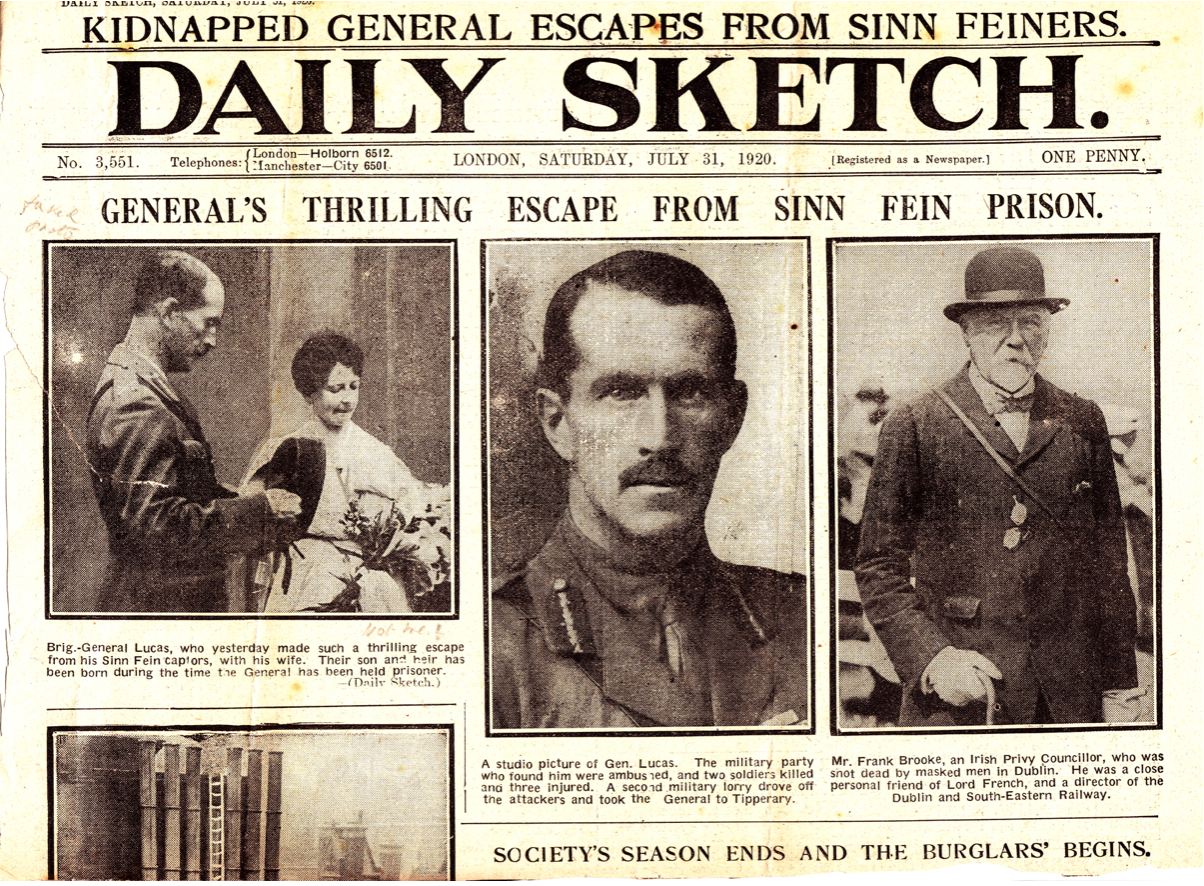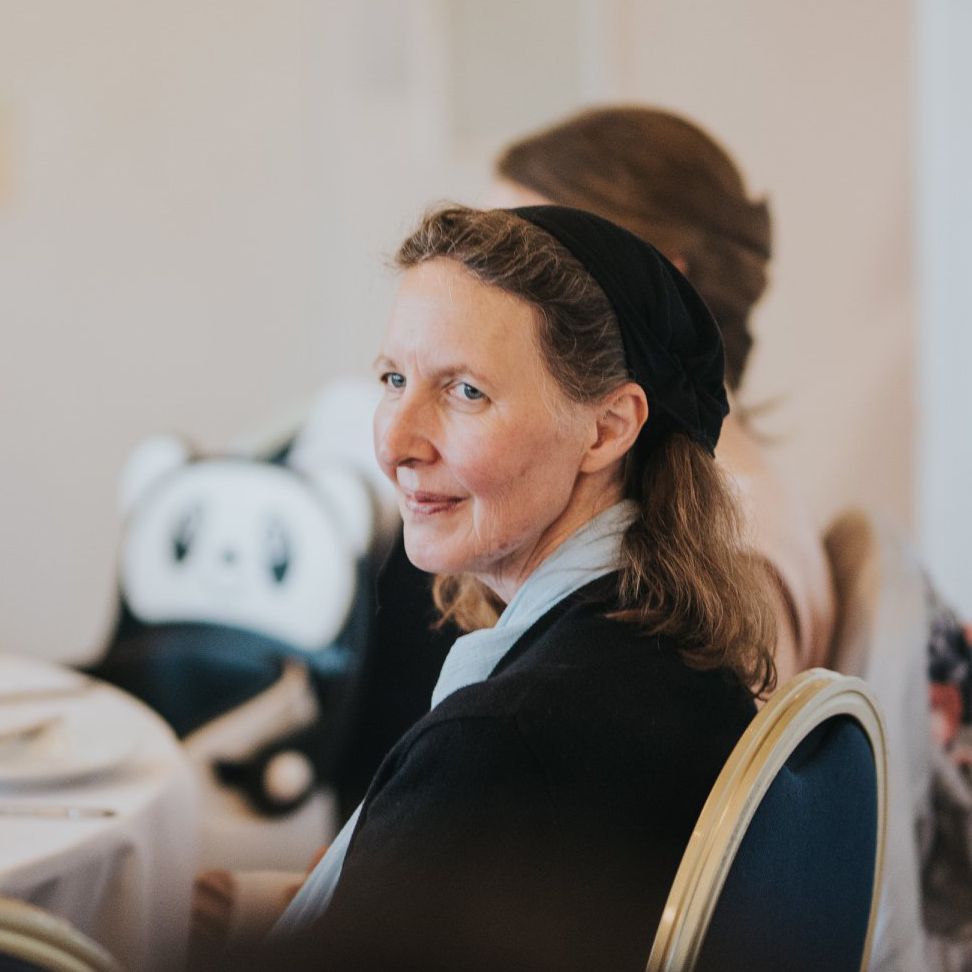29th July - No Letter
Secret diary: No more entries
Official diary: entry for 26th July continues…I stopped for a short time at CAHERELLY GRANGE or CASTLE till darkness and then proceeded to a farm just South of LANGFORD BRIDGE over the CAMOGIE RIVER I believe the farmhouse belongs to the owner of CAHERELLY GRANGE or he used to live in it. I stayed here until I escaped at 0200 hours on the morning of the 30th July. The window of the room in which I was sleeping was barred and by bursting one of these bars I managed to escape and in doing so burst a small blood vessel in my kidney.
Location: house near Herbertstown, Bruff.
Brennan was probably very aware of the broken window bars:
In the room he [CHTL] was in, the window was barred with ordinary bars that you would see in a farmhouse, but one of the bars was missing. The McCarthy’s in their young days had taken one of the bars out to enable them to get in and out the window when they were out late. It was through that window Lucas escaped.
BUREAU OF MILITARY HISTORY, 1913-21. NO. W.S. 656 Richard O’Connell, Member of Caherconlish Irish Volunteers 1914 Adjutant, 3rd Battalion O/C. 5th Battalion Mid-Limerick Brigade. O/C. Brigade Flying Column
Brennan wasn’t someone to have allowed such a security risk to have gone unnoticed: this was all part of his plan. He removed the guard at night from outside CHTL’s room, but on the first night (Wednesday) nothing happened and he thought that CHTL was suspicious. However on the second night (Thursday evening/Friday morning) his prisoner had escaped by removing a bar from the window.
Up to this we had always left a man on duty outside his bedroom window at night and now when the room was on the ground floor we withdrew this man. At first nothing happened (he may have suspected a trap), but when we got up on the second morning our prisoner was gone.
BUREAU OF MILITARY HISTORY, 1913-21. STATEMENT BY WITNESS. DOCUMENT: NO. W.S. 1,068 Witness Lieut.-Gen. Michael Brennan, Brigade Adjutant East Clare Brigade; Column Commander East Clare Flying Column. Subject. National activities, East-Clare,1911-1922.
Some of the IRA volunteers were kept in the dark and believed that their captive general had escaped entirely on his own initiative:
It was thought impossible to escape through the windows on account of the iron bars and, for that reason, the guard sat outside general Lucas‘s bedroom door and not inside as he was accustomed to do. It was not observed, however, that the middle bar was broken on top and about 1 foot length of it was missing. Evidently general Lucas studied this position during the first few nights of his detention there and, one morning when the Guard opened the door, he found that his prisoner had escaped.
BUREAU OF MILITARY HISTORY, 1913-21. STATEMENT BY WITNESS. DOCUMENT: NO. W.S. 1559. Morgan Portley, Company Captain, Ballybricken, Co. Limerick. Battalion Adjutant.
The story Bob was told by his father, was that there was only one guard posted outside CHTL’s room in the open air. In the early days of his capture there were always several armed guards inside his room, day and night. This relaxation of security would have been appreciated and noted. It was an indication that the general was not as valuable to his captors as he had been. It was pouring with rain so when a cup of tea was made for the guard he was called into the main house to drink it: 'you couldn’t drink a cup of tea in the rain'. This could well have been what the general thought. It must have been extremely stressful wondering whether he was being set up to be shot, or whether he actually did have a lucky break and could make it away in time.
When the guard didn’t return, CHTL began working on loosening the bar on the window (Bob was under the impression that the window was some sort of sky-light or at least quite high up, meaning that his father had to exert a lot of effort to climb up through it). Squeezing himself through the small gap caused CHTL to burst a blood vessel in his kidney, which resulted in him passing blood.
CHTL believed that he had escaped and was not under the impression that he’d been permitted to escape. However he would have picked up on Brennan’s hints and noted that the guard was being removed at night. He would have known that he was about to be moved on again to the care of a different brigade. He had built up a relationship with Michael Brennan, they’d shared fishing trips and been chased by the bull, they’d played cards late into the night, drinking and joking together and now he knew that he’d have to start all over again with a new set of men. Poppy was at breaking point, he’d had enough and he knew that things couldn’t go on indefinitely as they were. Tensions were rising, assassinations were happening and CHTL could see that the tide could so easily turn: his hope of reaching the shore could so easily be dashed and he could end up as yet another casualty of this unpredictable storm.
We know that CHTL was free on 31st July according to Major General Strickland’s diaries.
According to the 20th letter he escaped in the early hours of Friday 30th.

The first two arrows on the left show where CHTL was held, firstly at Caherelly Castle and then the farmhouse in Cahercorney, near Herbertstown. The third arrow points to Pallasgreen where CHTL hiked to. The fourth arrow shows where the Oola ambush took place on the 30th July.
The farmhouse in Cahercorney near Herbertstown was on the RS14 road to Limerick. When he made his escape, CHTL went across the fields until he reached Pallasgreen. By road this is 11.5km (7 miles). Possibly by going cross country it was longer, especially as the unfit general had to negotiate quite rough terrain in the dark and wouldn’t have taken the most direct route for fear of capture. The map below shows the direction that CHTL went in but not the route that he took.

"...across the fields, through woods, through ditches and hedges, any weather, any where."
Elizabeth Ashenden, the family nurse to Francis Lucas’ children. Francis was CHTL’s grandfather
Driven on by his indefatigable survival instincts plus his overwhelming desire to get back home to Poppy and his son, CHTL battled the elements and difficult terrain to make it to safety. He had calculated the direction he should take when out for his walks with Michael Brennan. He believed that at any moment the Volunteers would discover him absent and be after him.
In spite of the tennis, hay-making and walks, CHTL wasn’t as fit as he usually was and found the going very tough. He was also, for some reason, without his boots, so was navigating the rough terrain in his stockinged feet. He was not going to give up and, ignoring the worrying leaking of blood, the rain and wind, pushed on through the night.
Joe Good had suspected that CHTL had good navigational abilities some weeks before when the IRA were transporting their prisoner across the Shannon:
"Michael Brennan arrived in a punt or boat. It was late in the night and there was no attempt to blindfold Lucas, which I thought somewhat foolish. The general was calmly and concentratedly observing the stars. He was to prove to us all later that he was an excellent soldier and resourceful navigator."
Joe Good - Enchanted by Dreams p 163
CHTL was probably glad that he’d paid attention in Lt Col Fowler’s ‘Astronomy – diagram of stars’, classes at Staff College in 1913.
The Bird had Flown
Michael Brennan took some risk in letting CHTL go. He risked falling foul of senior IRA men. It was apparent that not all of those holding him were aware of Brennan’s decision to let loose his bird. Although no one was sorry that he did get away: if the order had come from above to assassinate CHTL there would have been none willing to have carried it out.
When he was gone, there was very little made about his going. No one was very sorry about his escape. He was a nice fellow and we liked him. Besides that, the business of holding him prisoner was a considerable lot of trouble. After Lucas escaping, we had to be very quiet and keep away from the police who were very active around our area that time. We kept quiet.
BUREAU OF MILITARY HISTORY, 1913-21. STATEMENT BY WITNESS DOCUMENT NO. W.S. 656 Richard O’Connell, Member of Caherconlish Irish Volunteers 1914 Adjutant, 3rd Battalion O/C. 5th Battalion Mid-Limerick Brigade. O/C. Brigade Flying Column
In probably a show of having attempted to recapture their prisoner, Morgan Portley of the Limerick Brigade was told to watch the roads for CHTL; but Michael Brennan knew that the general had taken across the fields. He’d realised that was what CHTL was planning by watching him take in the topography of the land whilst on their walks together. This was the route that Brennan had intended his prisoner to take.
Michael Brennan called for me and asked me to send out local Volunteers to watch the roads all around the area. The Volunteers were called out and all the roads in the area patrolled, but there was no trace of the escaped prisoner. Evidently he kept to the fields until he cut across to the main Limerick-Tipperary road and reached Pallas police barracks some time on the morning of 30th July 1920.
BUREAU OF MILITARY HISTORY, 1913-21. STATEMENT BY WITNESS. DOCUMENT NO. W.S. 1559. Morgan Portley, Company Captain, Ballybricken, Co. Limerick. Battalion Adjutant.
Meanwhile Nicholas O’Dwyer and the East Limerick Brigade were making plans to house the general, unaware that this unwanted cargo had already been off-loaded:
In connection with the escape of General Lucas I got instructions from Sean Wall to go to Jack Hartigan’s at Castleconnell and collect General Lucas. Before going, I had decided that General Lucas was to stay in East Limerick for as short a time as possible and I had arranged, I think it was with Jack McCarthy, to have him handed over through Kilfinane on to Cork. We did not want to have the trouble of holding Lucas as it was difficult to find a suitable place to keep him and it needed a general alertness and the services of a number of men to see that his whereabouts were not discovered by the British. The Cork Brigade, which had been responsible for his capture originally, were now agreeable to take him back and we decided to get him back to them as quickly as possible. On the day that we were to have taken him from Jack Hartigan’s Bill Hayes and myself got the County Surveyor’s car and left for Jack Hartigan’s, but on the way there we were met by a friend who told us that the bird had flown. He had escaped that morning.
BUREAU OF MILITARY HISTORY, 1913-21. STATEMENT BY WITNESS DOCUMENT NO. W.S. 680 Nicholas O’Dwyer, B.E., M.I.G.E.I., O/C. 3rd Battal- ion (Bruff) East Limerick Brigade, 1918-1921. Inspector of Local Government, Dali Eireann, 1921.
Lieut. -Col. John M. MacCarthy, Adjutant, East Limerick Brigade, was a little more astute and saw through the alleged ’escape’ tale as being a cover for Brennan releasing his bird.
Meanwhile, in July, 1920, I had made arrangements to accept custody of General Lucas, the British officer in command at Fermoy, Co. Cork, who had been captured near there some weeks previously Lucas was being moved from one locality to another, but the night before he was to reach my area he escaped. This, in fact, was welcome news to us as we saw that no advantage was being, gained by keeping him a prisoner at the cost of great inconvenience in guarding and suitably accommodating him. This, too, seemed to be the attitude of those in charge on the occasion of his escape as I am absolutely certain that the escape was a permitted one. The persons in charge of Lucas on that occasion were Michael O’Hehir and the Brennan brothers, of Co. Care, from whence Lucas had just been moved.
BUREAU OF MILITARY HISTORY, 1913-21. STATEMENT BY WITNESS. DOCUMENT NO. W.S. 883 Lieut. -Col. John M. MacCarthy, Adjutant, East Lim- erick Brigade; Member of East Limerick Flying Column. National and military ac- tivities, East Limerick, 1900-1921.
If CHTL had stayed he might well have enjoyed his next residence, which John M. MacCarthy had already lined up:
The place of intended detention I had arranged was in a large residence occupied by Mr. David Comon at Ballinanima, Kilfinane. Mr. Condon, a close friend of mine, and an extensive landowner had no political interests. He could, in general terms, be described as a nationalist and his co-operative attitude in this instance was the forerunner of the wonderful collaboration which all classes, rich and poor, extended to us in East Limerick as the struggle reached its climax.
BUREAU OF MILITARY HISTORY, 1913-21. STATEMENT BY WITNESS. DOCUMENT NO. W.S. 883 Lieut. -Col. John M. MacCarthy, Adjutant, East Lim- erick Brigade; Member of East Limerick Flying Column. National and military ac- tivities, East Limerick, 1900-1921.
Tadhg Crowley of the East Limerick Brigade was also not keen on looking after the IRA’s demanding prisoner but was under the impression that the bird had escaped - not been released:
On 28th or 29th July, ... I went to Kilfinane and stayed in the house of Mrs. O’Rourke in the Main Street. After arriving there, we were asked if the Column would take charge of General Lucas, that he was to be brought to David Condon’s in Ballinamina. I said that the Column could not do that kind of work, that it was a job for the local Company. The house he was being brought to was a very fine farmer’s place about a mile and a half from Kilfinane and North of the town.
The following morning after awakening, Mrs. O’Rourke’s daughter, Kathleen, brought the newspaper to our bedroom and said that General Lucas had escaped. He was in a farmer’s house between Herbertstown and Limerick end about one hundred yards from the main road North-East of the former. Apparently he had made his way across the fields to Pallasgreen police barracks.
BUREAU OF MILITARY HISTORY, 1913-2l. STATEMENT BY WITNESS DOCUMENT NO. W.S. 435 Tadhg Crowley, O/C. Ballylanders Company; Adjutant East Limerick Brigade; Member of East Limerick Flying Column.
The Volunteers were confused as to what had happened to their high profile prisoner, but there was a general sense of relief all round. Captors and captive were all pleased by the outcome.
The Times described the general’s exciting escape:
A later report states that General Lucas arrived in the small hours of this morning at Pallas Village police barracks, where, on informing the garrison who he was, he was taken in and kept...Rain fell in torrents all night, and General Lucas had great difficulty in making his way through the fields and across hedges. His tattered clothing and bedraggled appearance show the ordeal he had undergone.
The Times 30 Jul 1920


